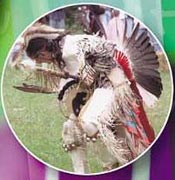| |
|||
|
Explore Your Community: A Community Heritage Poster for the ClassroomWhat Heritage Studies Can Do For YouExplore Your Community Poster Introductory TextWith this poster, the American Folklife Center and the Rural School and Community Trust hope to encourage middle and high school students to explore the wide range of living cultural expression that exists in their communities. The folklife and cultural heritage activities and resources included here will guide teachers in developing original research projects with their students. They also offer young people creative ideas for engaging in cultural heritage research outside the classroom. And, finally, they demonstrate how students can learn to "read" the living traditional culture in their midst so that their community becomes, in essence, the classroom. It is important for young people to learn that culture, history, art, and music are not just created by historical figures, famous people, or those living in other places. Culture is created in everyday life by all of us in our various communities, whether in our families, our schools, our neighborhoods, or in ethnic, occupational, or other kinds of groups. You can illuminate and expand classroom instruction with real-world experiences and connect students to their communities—in ways that capture students' attention, enrich their learning experience, and improve essential reading, research, communications, and writing skills. In addition, students will be contributing to understanding and shaping the culture and traditions of their communities. By doing cultural heritage research in their own communities, students will discover the rich and often diverse traditions around them and make valuable connections to history, place, and environment. In working on projects such as those listed here, you will help students understand culture by connecting to their communities—and by interacting with their own relatives, people in senior centers, local craftspersons, musicians, storytellers, artisans, and experts in local history. They can visit places of historical or local significance while they document family, school, and neighborhood traditions using tape recorders, video and still photography, and basic observational skills. Likewise, you as the teacher may want to invite people with occupational expertise, storytellers, local historians, traditional musicians or dancers, and others into the classroom to enliven and illustrate the classroom experience. Bringing Heritage Studies into the curriculum:
|
| ||||

